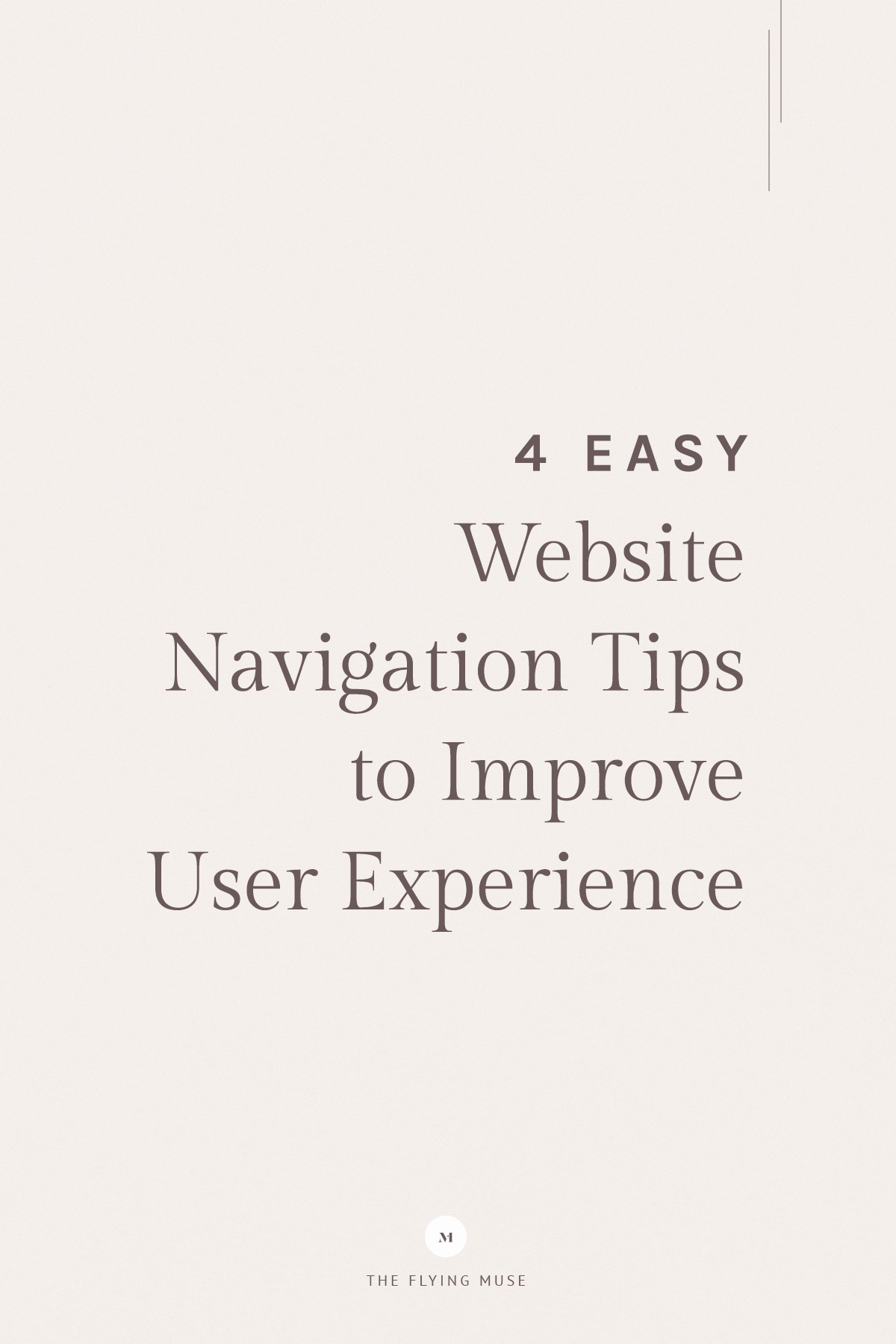When starting your own website design project, the major emphasis or decision is always on the overall look and feel of the website – website design. However, website design is not only about the color palette used, and coding according to the latest practices.
Moreover, it is essential to decide where and when to display the logo and the navigation menu to visitors.
After all, you want to provide an easy, yet natural flow and navigation experience, while at the same time your visitors to be able to recognize and remember where they are. This is usually done by including your branding – your logo and perhaps a slogan.
After working on numerous custom ProPhoto and Showit website design projects, as well as on my own collection of ProPhoto and Showit templates I gathered an invaluable experience and developed a sense of how to plan and structure the best very best navigation for your website.
I compiled this list of 4 Easy Website Navigation Tips that will help you in increasing your website user experience.
But first, let’s go over some basics. If you are here only for the tips just jump to the first tip.
Table of Contents
- What is user experience and why does it matter?
- Why is your website navigation important?
- How to plan your website navigation?
- Key Takeaway: Website Navigation Tips to Improve User Experience
What is user experience and why does it matter?
When talking and defining what user experience one of the best definitions I found is by Wikipedia.
User experience (UX) is a person’s emotions and attitudes about using a particular product, system or service. It includes the practical, experiential, affective, meaningful and valuable aspects of human–computer interaction and product ownership. Additionally, it includes a person’s perceptions of system aspects such as utility, ease of use and efficiency. User experience may be subjective in nature to the degree that it is about individual perception and thought with respect to a product or system. User experience varies dynamically, constantly modifying over time due to changing usage circumstances. Simplified, user experience is about how a user interacts with, and experiences, a product. ~Wikipedia
What this basically means is – you need to know your visitor and predict where, how, and when they will need a piece of information from your website.
The only goal for you is to display your content at the time your website visitors want and need it the most.
Why is your website navigation important?
Website navigation is only one small part of the overall user experience. However, it is an essential one.
By giving an easy-to-find and use navigation for your website, your visitors will be able to navigate to the right information at the right time.
One of the biggest mistakes is if your website navigation is not as easy to use and understand by the user. You don’t want your precious website visitor to get lost in a wormhole, don’t you?
How to plan your website navigation?
Planning website navigation comes after you have planned the complete website structure. A very good practice is to figure out what are the most important pages on your website. Figuring out this is easier for small-sized websites. However, larger websites can pose a challenge.
After you had defined the overall website structure and figured out and defined the most important pages for your visitor, you will need to make sure these web pages are included in your main website navigation.
The next thing to think about and decide on is the layout and the position of your main navigation menu. I included several tips below to ease the process for you in deciding on the best position for your website navigation is.
1 | Bottom of a page navigation
Placing brand elements and information at the very bottom or at last is most seen in advertisements and TV commercials.
However, when watching TV, we actually do not choose what we will see while the advertisement plays. We cannot decide to pause or which part to skip in an advertisement – I mean we can with the latest technology but tell me one person who does that! 🙂
This is very different when it comes to websites.
If you have engaging and tailored content for your target audience, you can keep visitors on your website, in some cases even for hours.
While navigating, if you position the navigation and your branding at the very bottom of your website, any visitor or user will have to go through all of your content to navigate to another page. They will have to do this, even if they DO NOT want to read all that info or accidentally stumbled upon a page. This is considered – an extremely bad practice when it comes to user experience.
If you decide to anyway go down this route, you should be aware of the risk – visitors never really remember anything at all other than the content they last saw.
Not only that!
No one wants to come to a website and get stuck in an endless scroll to get to the main navigation, and to actually struggle to find where your pages are or what type of content can be found on your website.
Remember, one of the most important aspects of user experience is to make the experience enjoyable and easy for the target audience.
2 | Top of a Page navigation bar and branding
Placing the navigation bar and the logo at the top of a page, most probably started out of convenience.
When the World Wide Web was just starting out, people were used to reading traditional newspapers and magazines.
With layout design, you always aim to place the logo and title at the top of the page. This is just because of how a reader, user, or visitor’s eyes naturally flow when reading content.
However, this is almost always different in advertisements or TV commercials.
Secondly, again back in time, this convention started as a result of slow internet connections, when images and content took a tremendous time to load.
As a website owner, you would want to present your user with the information ‘Where am I?’ as soon as possible. And, most probably within the very first few seconds, too!
The navigation, menu, branding elements should be one of the first things your users and visitors will notice without having to wait for the rest of the page to load.
3 | Usability standpoint
From a usability standpoint, it would be too much of a hassle for a user to scroll to the very bottom of a website – every single time they want to navigate to another page.
If anyway your preference is to display your website navigation at the very bottom of your website, you can add an additional (supporting) navigation. You can include also navigation to some of the most important pages on your website. This is very common practice with e-commerce websites, where links to the terms and conditions, policies, your shopping account, etc. are usually included.
However, be aware that this could lead to an increased bounce rate as visitors would be encouraged to jump from one page to another. So, make sure to include only the very important links and must-haves in the footer navigation.
Another argument why the logo and the main navigation menu should stay at the top of the page is that visitors’ eyes in most cultures – left to right reading, generally, skim through content from the top left of the page and then move across and through the page in a clockwise way.
If your site is presented to this type of audience, placing the navigation menu and branding at the bottom, would mean your visitors will get or see this content at last. And, you don’t want that, do you?
4 | Other important website navigation tips
Some more important tips to consider in making a decision on your website design, the position of the navigation menu, branding, and presentment of social network profiles:
- You may want to consider placing a link ‘to the top’ at the very bottom of each page on your website. This will easily provide your users and visitors a quick way to get back to the very top of your website and access the main navigation;
- Place navigation menu in the footer or just below the footer section. This way users can navigate to your most important pages when finished reading the content. This position is perfect for contact us link, or about page and link to your shop.
- Don’t distract your visitors with too many social profiles. Today’s websites are all about social media and social interaction. However, it doesn’t mean you are successful if you are all over the web. It is better to place only a few social media links to your profiles. The best position from my own experience to position and a way to display social networking profile links in the footer, or in the header of your website. This should be done with stylized buttons cohesive to your overall website design. However, make sure the buttons leading to your social network profiles are not large to the extreme. The main reason why a visitor will choose to follow your posts is the quality of the content, not how big and impressive your social network icons are.
Key Takeaway: Website Navigation Tips to Improve User Experience
The discussion for placing the navigation menu and logo and their position could be done for hours.
I hope that these website navigation tips I provided will aid you in deciding and planning your website content and design.
However, you will need to remember.
The final decision on how and where to place your navigation menu and branding is totally up to you.
You are the only person who knows your users and visitors, your target audience, and how they interact with your content.
Just make sure you follow the ultimate goal – to make a convenient, easy and enjoyable experience getting to the right content at the right time on your website.


